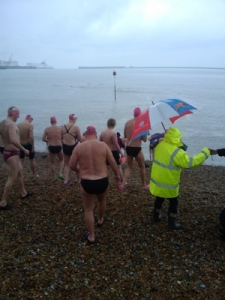Tempting fate is never a good idea. I was so busy gloating about how many lengths I could do that I didn’t see it coming. As Oxford’s finest were leaping off the Magdalene Bridge in a tradition that dates back to the dawn of alcopops, I was preparing to take a road trip. Though, not by road you see, because that wouldn’t be very eco. I took a train to the coast to dive into the depths of Dover harbour. And despair.
Swimming in the sea is nothing like swimming in a pool. I know that because I’ve read it several times since undertaking this challenge. And because I have swum in the sea plenty of times before. I was even in the sea last October. Surely May couldn’t throw any surprises?
Sometimes you are so wrong about things that your own stupidity hits you like a sledgehammer.
The sea is at its warmest at the beginning of September, when it can reach 19C. Which means that it is still fairly temperate in October, probably around 15C. This was my first mistake. Dover harbour on May Day was just 9C.
It’s not cold, it’s character building
To kick off our training, we did two swims, for just 15-20mins, two hours apart. You need that long to recover. During the first swim, I had to be pulled out of the water because all my limbs went numb. On the second swim, the wind picked up and choppy salt water sloshed round my mouth like it was a plughole in a gargantuan bath tub.
And then came the shivers, like being held by the shoulders and shaken violently. Apparently this is normal, you only need to worry when it doesn’t happen. I had to be helped to dress myself. Someone bought me a cup of tea and held it as I drank. In this indignity, I found comfort in the kindness of strangers.
It may have been a lonely journey doing lengths in the pool, but there are literally dozens of people willing to subject themselves to the vagaries of the sea in the name of channel swimming. And thankfully, a handful of volunteers who pick up the pieces when the sea spits you out.
Flirting with hypothermia
After the shakes came the wobble. The moment where I started to think that maybe I was a bit crazy to be doing this. Why didn’t I spend my summer lying on the beach like normal people, instead of flirting with hypothermia? But I felt a bit better when I read this on the website of the Outdoor Swimming Society:
“0-11 degrees: freezing. Jumping in likely to impair breathing in the uninitiated, as breath comes in big jolting grasps and it feels like someone has clamped on an ice neck brace. Water has bite, skin smarts and burns. Limbs soon become weak – 25 metres can be an achievement.”
And of all the people who recoiled on hearing of my water torture, I knew there would be one person who would ‘get it’. The kind of person who subjects themselves to extreme temperatures for professional curiosity. Lloyd is our Head of Global Field Safety at Earthwatch. He’s like a cross between Ray Mears and Colt Severs. He’s exactly the sort of person you would want to have around in a crisis. But there are no crises in Lloyd’s world, only situations. I imagine he’d be pretty handy in one of those too.
Hot is the new cold
You might wonder why I’m banging on about how cold it is, when 2010 is set to be the hottest year on record. The crucial factor is that this represents average global temperatures. So it will not be warmer everywhere. Believe it or not, where you live is not the centre of the universe, but you’d be surprised how many people think it is. Like here in the UK, where our unseasonably cold winter probably did as much to dent public confidence in global warming as Climategate.
So really I should revel in our cold sea, because soon it could be like bathing in the Riviera. Like exam standards and children’s behavior, in a few decades time, swimming the channel will not be the feat it once was. And while part of me would be a tiny bit grateful for the respite, it is cold comfort when you consider the devastating effect on sea levels and marine life.
And somehow, using a little less goose fat doesn’t seem like a good enough reason to do nothing about climate change.



